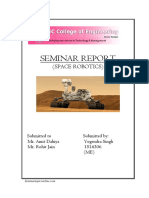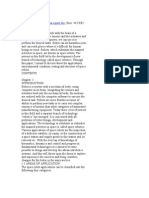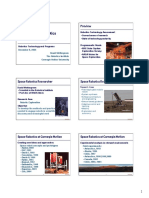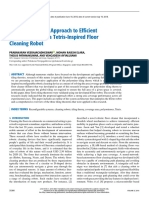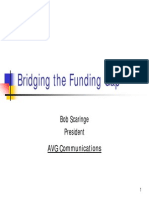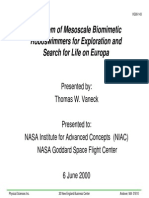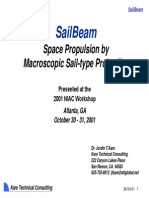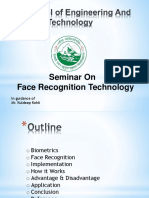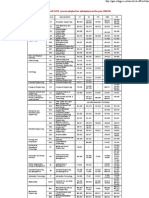0% found this document useful (0 votes)
201 views25 pagesAutonomous Self-Extending Machines For Accelerating Space Exploration
This document proposes developing self-extending fabrication systems that can autonomously build and expand functional machines in space to accelerate exploration. Current robotic missions have long development cycles and inflexible designs. The concept involves compact fabricators that can build larger systems from local resources with minimal inputs. They analyze required capabilities and survey technologies like 3D printing and additive manufacturing. Their goal is a fully autonomous system that can fabricate a functional mobile robot to prove the feasibility of self-extending fabrication for space applications.
Uploaded by
Clifford StoneCopyright
© © All Rights Reserved
We take content rights seriously. If you suspect this is your content, claim it here.
Available Formats
Download as PDF, TXT or read online on Scribd
0% found this document useful (0 votes)
201 views25 pagesAutonomous Self-Extending Machines For Accelerating Space Exploration
This document proposes developing self-extending fabrication systems that can autonomously build and expand functional machines in space to accelerate exploration. Current robotic missions have long development cycles and inflexible designs. The concept involves compact fabricators that can build larger systems from local resources with minimal inputs. They analyze required capabilities and survey technologies like 3D printing and additive manufacturing. Their goal is a fully autonomous system that can fabricate a functional mobile robot to prove the feasibility of self-extending fabrication for space applications.
Uploaded by
Clifford StoneCopyright
© © All Rights Reserved
We take content rights seriously. If you suspect this is your content, claim it here.
Available Formats
Download as PDF, TXT or read online on Scribd
/ 25
Autonomous Self-Extending
Machines for Accelerating Space
Exploration
NIAC CP 01-02 Phase I
Hod Lipson, Evan Malone
Cornell University
Computational
Synthesis Lab
Computat i onal
Synt hesi s Lab
Motivation
Robotic exploration has a long cycle time
Better propulsion
Mission goals are inflexible
Design more complex robot
Failure is catastrophic
Make more stringent reliability testing
Vicious circle of cost and complexity
Computat i onal
Synt hesi s Lab
Concept
Remote autonomous fabrication of complete
functional systems
Design after launch (shorter cycle)
Less commitment (more flexibility)
Task specific robots (less complex)
Repair and recycle (reliability less critical)
Computat i onal
Synt hesi s Lab
Prior concepts
Self replicating lunar factories
It more efficient to send information in preference
to matter
Ambitious future missions can be greatly
shortened through remote factories
Self-extending facilities can have much more
flexibility
Advanced Automation for Space Missions, Robert A. Freitas, Jr. and
William P. Gilbreath, editors.
Computat i onal
Synt hesi s Lab
Our concept
Fabrication system that is
Compact
Fully autonomous
Can fabricate fully functional systems
Can build systems larger than itself
Can build repair / extend itself
High gain fabrication system: SFF
Computat i onal
Synt hesi s Lab
SFF: Two architectures
Comprehensive
Can make anything
Has every conceivable fabrication method
Catch: Shifts the cost and reliability to SFF
Minimal
Has a minimal spanning base of materials
Cannot make all things, but can achieve any functionality
Catch: Requires re-parsing of design in terms of available
capabilities
Computat i onal
Synt hesi s Lab
Example:
A possible minimal architecture
Articulated arm SFF
structure, actuation, sensing, power, control,
recycling
Assembly
Multiple identical arms cooperate
Redundancy
Self repair
Computat i onal
Synt hesi s Lab
Summary of proposal
Analyze missions requirements
Consider a variety of destinations
Survey available and foreseeable SFF
technologies
1. Provide roadmap to alternative architectures
2. Evaluate architecture through limited
implementation
Computat i onal
Synt hesi s Lab
Background on SFF
Introduction to Solid Freeform Fabrication
State of Solid Freeform Fabrication Today
Materials
Processes
Products
Markets
Developmental trends
Computat i onal
Synt hesi s Lab
Commercial SFF Processes
Fused Deposition Modeling (FDM)
Laminated Object Modeling (LOM)
Stereo Lithography (SLA)
Selective Laser Sintering (SLS)
3-D Printing / Multijet Modeling
Laser Direct Metal Deposition (DMD / LENS)
Computat i onal
Synt hesi s Lab
Research in SFF Processes
Piezo actuators / sensors via
LOM, SLS, FDC/FDMM,
including electrodes (Rutgers)
Fabrication of SiC / C
thermocouples on Al
2
O
3
ceramic, and welding (CVD)
of ceramic via SALD (U.Conn.)
Universality by CMU/Stanford
SDM
Passive circuit elements by
laser processed sol-gel
materials (Sciperio)
DMD of on-demand spare
parts in space
FDM in zero-g (Vomit Comet)
Focused Solar Sintering / OW
Electron Beam SFF
Computat i onal
Synt hesi s Lab
Future of SFF in Missions
Near-term, near Earth:
Spares on demand / inventory reduction for ISS too
easy (for NIAC!) and already underway
Mid-term, Moon, Mars:
Repair / extension of planetary landers / rovers,
Preparation of facilities / resources for manned mission
Long-term, Outer planets, beyond:
Very distant scientific missions
Essential component of indefinite duration robotic
mission / self-replicating robotic ecosystem
Computat i onal
Synt hesi s Lab
Mission Requirements
What do these missions require of a fabrication
system?
Produce Functional Components / Functional Systems
Compact size, low mass
Energy efficient
Large functional gain / small set of inputs
Simple, robust, and safe system
Tailored for use of in situ resources and products of ISRU
and recycling
Fully automated, high yield process
Example: Architecture for MARS
A
t
m
o
s
p
h
e
r
e
F
e
e
d
s
t
o
c
k
s
N
o
n
-
S
F
F
-
a
b
l
e
s
R
e
c
y
c
l
e
d
C
o
m
p
o
n
e
n
t
s
,
M
a
t
e
r
i
a
l
s
O
b
s
o
l
e
t
e
/
D
a
m
a
g
e
d
Computat i onal
Synt hesi s Lab
Two thrusts of development
#1: Universality of the fabrication process
Commercial development of SFF processes for
mass customization
What is not likely to be achieved by commercial
efforts?
Process integration, compaction (too many proprietary,
no motivation)
Basis sets of materials / ISRU focus
Production of fully functional systems in SFF style
100% automation
Computat i onal
Synt hesi s Lab
Two Thrusts of Development
#2: New design paradigms: Design for
Solid freeform fabrication of fully functional
systems (different components, multi-materials,
wild geometry)
Use of In situ resource feedstocks
Highly constrained material selection
Automated recycling / reuse
Automated assembly / disassembly
Automated extension / replication
Design Process for Fabricator
Mission
Projected Mission Design
Mission Specification
Resources Model
Expected In situ raw materials
Expected energy sources (solar,etc.)
Expected temperatures, pressures, radiation,
etc.
Earth-originating resources, components, etc.
Earth-based computational resources
Mission Earth-originating mass limitation
Manufacturing Technology Model
Mapping from set of input feedstocks to set of
output products
Intrinsic properties of manufacturing systems
ISRU Technology Model
Mapping from set of input raw materials to set
of output materials
Intrinsic properties of ISRU systems
Recycling Technology Model
Mapping from set of input feedstocks
(including power) to set of output products
Intrinsic properties of recycling systems
Mission Functionality Model
Specification of functionality desired as
decision tree - depending on time, discovery,
etc.
Design Automation
Tools
Evolutionary algorithmic
methods
Design Paradigms
Simulation
Projected Achievable
Functionality
Result of constrained automated design
Analysis
Identify essential
missing technologies
Identify binding mission
constraints
Projected Resource and
Technology Utilization
Technologies employed by simulated mission
Resources consumed in simulated mission
Computat i onal
Synt hesi s Lab
Technology Evaluation Platform
Small scale, 6 axis industrial robot arm
Multiple tools
Linear motor driven hot extruder for
thermoplastics (polypropylene)
Pneumatic dispenser for conductive grease,
silicone RTV elastomer
Hot pneumatic dispenser for low-melt alloy
Automatic part slicing and path planning
software
Computat i onal
Synt hesi s Lab
Progress
Automatic tool changing
Tool control
Multiple tools means many processes to refine
and control
Using OOP to simplify interface
Hardware is very heterogeneous
Path following: planar raster paths for now
All the pieces are working together!
System
Dispensers
Results
Computat i onal
Synt hesi s Lab
System in Action
Computat i onal
Synt hesi s Lab
Near Term Goals
SFF Actuators
Electroactive Polymer
Actuators
Extruded solenoid
Power storage
Printable Zinc-air battery
Controls / Electronics
Mechanical switches
Resistors
Capacitors
Build minimal functional
mobile robot!
Computat i onal
Synt hesi s Lab
Conclusion / Recommendation
Solutions foreseeable for structures, articulation,
actuation, conduction
Key Challenges
Develop SFF power storage, control logic
Integrate basis set of processes into compact system
Develop design paradigms for SFF, complete functional
systems
Our role and plan
Seek functional universality
100% automation
Fabricate entire functional robot

